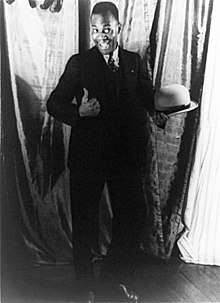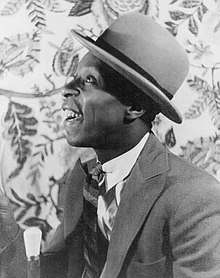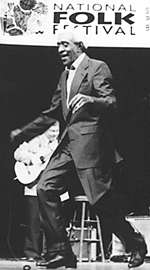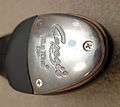Tap dance
Tap dance is a type of dance characterised by using the sounds of metal taps affixed to the heel and toe of shoes striking the floor as a form of percussion, coupled with both characteristic and interpretative body movements. Its roots were in minstrel shows, it gained prominence in Vaudeville, then emerged into an art form and means of expression alongside the evolution of jazz.

There are several styles of tap dance, including rhythm (jazz), classical, Broadway, and post-modern. Rhythm tap, the most celebrated and best known, focuses on musicality, and practitioners consider themselves to be a part of the jazz tradition and as such, improvisation is essential to their work. Many influential rhythm tap dancers were members of the Hoofers Club. Soft-shoe is a close relative of rhythm tap dancing that does not require tap shoes. Rhythm is generated by tapping the feet, and also by sliding the feet (sometimes using scattered sand on the stage to enhance the sound of sliding feet). It produced what is currently considered to be modern tap, but has since declined in popularity. Classical tap has a similarly long tradition which marries European "classical" music with American foot drumming with a wide variation in full-body expression. Broadway tap often focuses on formations, choreography and generally less complex rhythms; it is widely performed in musical theatre. Post-modern or contemporary tap has emerged over the last three decades to incorporate abstract expression, thematic narrative and technology.
History

Tap dance has its roots in several ethnic percussive dances, including Gioube Juba Dance, English clog dancing and Irish jigs. The relative contribution of different traditions is a point of disagreement among historians and dance scholars.[3] Tap dance is thought by some to have begun in the mid-1800s during the rise of minstrel shows. Known as Master Juba, William Henry Lane became one of the few black performers to join an otherwise white minstrel troupe, and is widely considered to be one of the most famous forebears of tap dance.
As minstrel shows declined in popularity, tap dance became increasingly popular in Vaudeville. Due to the "two-colored rule", which prohibited black people from performing solo, the majority of vaudeville tap acts were duets.[4] This gave rise to the famous pair "Buck and Bubbles", which consisted of John "Bubbles" Sublett tap dancing and Ford "Buck" Washington on piano. The duo perfected the "class act", a routine in which the performers wore impeccable tuxedos, which has since become a popular theme in tap dance. This contrasted with the older minstrel concept of tap dancers as a "grinning-and-dancing clowns." Sublett is also known among hoofers as the "Father of Rhythm Tap" which incorporates more percussive heel drops and lower-body movements.[5][6]
Another notable figure to emerge during this period was Bill "Bojangles" Robinson, a protégé of Alice Whitman of the Whitman Sisters around 1904 (then 'Willie Robinson').[7] Well-versed in both Buck and Wing dancing and Irish step dancing, Bill Robinson joined the vaudeville circuit in 1902, in a duo with George W. Cooper. The act quickly became famous, headlining events across the country, and touring England as well. In 1908, however, the two had an altercation and the partnership was ended. Gambling on his popularity, Robinson decided to form a solo act, which was extremely rare for a black man at that time.[8] Despite this, he had tremendous success and soon became a world-famous celebrity.[4] He went on to have a leading role in many Hollywood films, notably in movies starring Shirley Temple.
Shortly thereafter, the Nicholas Brothers came on the scene. Consisting of real-life brothers Fayard and Harold, this team wowed audiences with their acrobatic feats incorporated into their impossibly syncopated and classy style of dancing. They never looked less than suave and were always in total control of their dancing, even in childhood numbers such as Stormy Weather.[9] A notable scene in the movie Stormy Weather features the pair dancing up a staircase and then descending the staircase in a series of leapfrogs over each other into a full split from which they rise without using their hands.
During the 1930s tap dance mixed with Lindy hop. "Flying swing-outs" and "flying circles" are Lindy hop moves with tap footwork. In the mid- to late 1950s, the style of entertainment changed. Jazz music and tap dance declined, while rock and roll and the new jazz dance emerged. What is now called jazz dance evolved from tap dance, so both styles have many moves in common. Jazz dance has since evolved separately from tap dance to become a new form in its own right. Well-known dancers during the 1960s and 1970s included Arthur Duncan and Tommy Tune.
Revival

No Maps on My Taps, the Emmy award-winning PBS documentary of 1979, helped begin a modern revival of tap dance. The outstanding success of the animated film, Happy Feet, has further reinforced the popular appeal.[10] National Tap Dance Day in the United States, now celebrated May 25, was signed into law by President George Bush on November 7, 1989. (May 25 was chosen because it is the birthday of famous tapper Bill "Bojangles" Robinson.) Prominent modern tap dancers have included Sarah Reich, Brenda Bufalino, Melinda Sullivan, The Clark Brothers, Savion Glover, Gregory and Maurice Hines, LaVaughn Robinson, Jason Samuels Smith, Roxanne Butterfly, Chloe Arnold, Michelle Dorrance, Dulé Hill and Dianne "Lady Di" Walker.[11][12] Indie-pop band Tilly and the Wall also features a tap dancer, Jamie Pressnall, tapping as percussion.
Characteristics

Tap dancers make frequent use of syncopation. Choreography typically starts on the eighth or first beatcount. Another aspect of tap dancing is improvisation. Tap dancing can either be done with music following the beats provided, or without musical accompaniment; the latter is known as "a cappella tap dancing".
Hoofers are tap dancers who dance primarily "closer to the floor", using mostly footwork and not showing very much arm or body movement.[13] Steve Condos developed an innovative rhythmic tap style that influenced the work of later tap dancers such as Gregory Hines and Savion Glover. Condos passed his knowledge on to his protege Marshall L. Davis Jr. The majority of latter-half 20th century hoofers, such as Sammy Davis Jr., Glover, Hines, and LaVaughn Robinson were African American men.[14] Savion Glover helped bring tap dance into mainstream media by choreographing Happy Feet, a film about a tap dancing penguin. Another well-known tap film is 1989's Tap, starring Gregory Hines and many old-time hoofers.
Early tappers like Fred Astaire provided a more ballroom look to tap dancing, while Gene Kelly introduced ballet elements and style into tap. This style of tap led to what is today known as Broadway style, which is popular in American culture. It often involves high heeled tap shoes and show music, and is usually the type of tap first taught to beginners. Examples of this style are found in Broadway musicals such as Anything Goes and 42nd Street.
Common steps
Common tap steps include the shuffle, shuffle ball change, double shuffle, leap shuffle, hop shuffle, flap, flap ball change, running flaps, flap heel, cramproll, buffalo, Maxi Ford, Maxi Ford with a pullback, pullbacks, wings, Cincinnati, the shim sham shimmy (also called the Lindy), Irish, waltz clog, the paddle roll, the paradiddle, stomp, brushes, scuffs, spanks, riffs, and single and double toe punches, hot steps, heel clicks, time steps, over-the-tops, military time step, New Yorkers, Shiggy Bops, drawbacks, and chugs. In advanced tap dancing, basic steps are often combined together to create new steps. Many steps also have single, double, and triple versions, including pullbacks, timesteps, and drawbacks. In tap, various types of turns can be done, including step heel turns, Maxi Ford turns, cramproll turns, and drag turns. Timesteps are widely used in tap and can vary in different areas. These consist of a rhythm that is changed to make new timesteps by adding or removing steps.
In group tap dances, the steps are typically kept simple and easy to control. The group of dancers must work together to create the sound, keeping their steps at the correct speed to match each other.
Tap dancing can also be done using an a cappella method, in which no musical accompaniment is provided and dancers creating their own "music" through the sounds of their taps.
Tap shoes

In the earliest years of tap dancing, tap shoes often had wooden soles,[15] but most tap shoes since have had leather soles. Today, it is common for manufacturers of tap shoes to also produce and fix taps. There are a variety of styles of shoe: the Oxford is very common in jazz dance and the Mary Jane is common for younger girls in tap classes.
Tap shoe makers include Bloch, Sansha and Capezio.
Taps
Metallic taps were added to tap shoes in 1910.[16] Before that tap shoes used wood to produce a distinct tapping sound. Castanets were commonly used for larger shows with full orchestration. Depending on manufacturer and model, tap characteristics can vary considerably. For example, some taps have relatively low weight and small footprint, whereas others may be thicker and fill out the edge of the shoe more, making them heavier as a result. A tap's "tone" is influenced by its weight as well as its surface shape, which may be concave or convex.[17] The tonal quality of a tap can also be influenced by the material it is made from,[18] the tightness or looseness of its screws, and the presence of a soundboard (though there is some debate whether this affects the sound).
 Side view of tap shoe, showing taps mounted to bottoms of heel and toe
Side view of tap shoe, showing taps mounted to bottoms of heel and toe Metal tap on bottom of heel
Metal tap on bottom of heel Metal tap on bottom of toe
Metal tap on bottom of toe
Taps are mounted to the sole of the shoe with screws, and sometimes adhesive as well. The screws are driven into a soundboard – a thin fiberboard integrated into the sole that can be firmly "gripped" by the screws – to reliably attach the tap to the shoe. When no adhesive is used, the screws can be loosened or tightened to produce different sounds, whereas tonal quality is fixed when adhesive is used.
See also
References
- Atkinson, Ted (2006). Faulkner and the Great Depression: Aesthetics, Ideology, and Cultural Politics. p. 223.
- "Bill "Bojangles" Robinson | The Stars | Broadway: The American Musical | PBS". Broadway: The American Musical. Retrieved 2020-01-29.
- Seibert, B. (2015). What the Eye Hears: A History of Tap Dancing. Farrar, Straus and Giroux. pp. 445–6. ISBN 978-1-4299-4761-9.
- Gates, Henry Louis. Harlem Renaissance: lives from the African American national biography. Oxford University Press, 2009, p. 429.
- "Beginning Tap Dance: Learn the styles and aesthetics of tap dance". human-kinetics. Retrieved 2016-10-22.
- Tap Dance Hall of Fame, 2002 Inductee: John Bubbles
- Thomas F DeFrantz (April 1, 2002). Dancing Many Drums: Excavations In African American Dance. Univ of Wisconsin Press.
alice whitman bojangles.
- David Hinkley, Gregory Hines (February 4, 2001). "HERE'S TO YOU, MR. ROBINSON". The Daily News.
- Hill, Constance Valis; Dunning, Jennifer; Hines, Gregory (2002-01-01). Brotherhood in Rhythm: The Jazz Tap Dancing of the Nicholas Brothers. Rowman & Littlefield. ISBN 9780815412151.
- Sarah Kaufman (December 17, 2006). "Tapping a Gold Mine of Motion". Washington Post. Retrieved December 16, 2007.
- "Grant Swift homepage". Archived from the original on 31 August 2007. Retrieved 16 September 2010.
- "Dance: The rhythm of truth". March 21, 2007. Archived from the original on November 5, 2007. Retrieved December 16, 2007.
- Valis Hill, Constantine (2010). Tap Dancing America. Oxford University Press. p. 388. ISBN 978-0-19-539082-7."Hoofer, a tap dancer who emphasizes movements from the waist down, and concentrates on the flat-footed percussive intricacies of the feet"
- http://www.itaplive.com/backstage.html
- The Origin Of Tap Dance, Beholders.org, 12 Sept 2011
- Hill, Constance Valis. "Tap Dance in America: A Short History". Library of Congress, Washington, D.C. 20540 USA.
- "Customizing Your Tap Shoes: The Taps". Dance Advantage. 2011-07-05. Retrieved 2013-02-25.
- "Bloch Techno Heel Tap Shoes". Bloch. 2007-10-08. Retrieved 2013-02-25.
Further reading
- Constance Valis Hill. Tap Dancing America: A Cultural History (Oxford University Press; 2010, 400 pages; Traces the history of tap from its origins in African-American and Irish forms.
- Jerry Ames and Jim Siegelman, The Book of Tap: Recovering America's Long Lost Dance David McKay Co, 1977. 178 p. ISBN 0679506152
- Seibert, Brian (2015). What the Eye Hears: A History of Tap Dancing. New York: Farrar, Straus and Giroux. ISBN 9781429947619.
External links
| Wikimedia Commons has media related to Tap dance. |
%2C_by_William_H._Johnson.jpg)